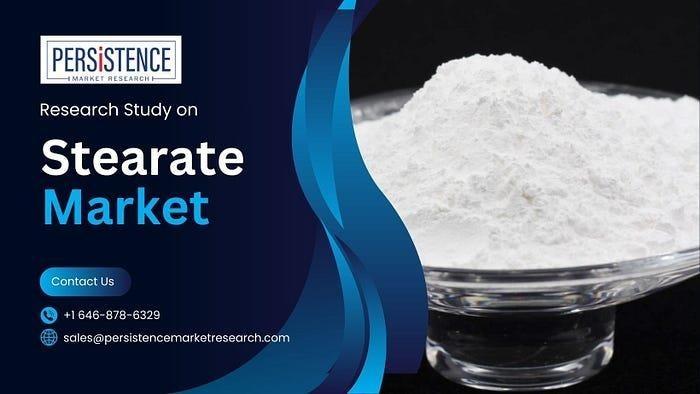Stearate Market Opportunity | Size | Research Report

Introduction
The global stearate market is experiencing significant growth, driven by its extensive applications in various industries such as plastics, rubber, pharmaceuticals, and cosmetics. Stearates, salts of stearic acid, are used as lubricants, stabilizers, and release agents, making them indispensable in manufacturing processes. This blog post explores the opportunities within the stearate market, provides insights into its size, and highlights key findings from recent research reports.
Market Overview
The global stearates market is projected to rise from US$1.38 Bn in 2024 to US$2.29 Bn by the end of 2033. The market is anticipated to secure a CAGR of 5.8% during the forecast period from 2024 to 2033. This growth is attributed to increasing demand from end-use industries, technological advancements, and the rising need for efficient manufacturing processes.
Key Drivers of Growth
1.
Rising Demand in the Plastics and Rubber Industries
Stearates are widely used in the plastics and rubber industries as lubricants and release agents. They help in improving the surface finish, reducing friction, and enhancing the overall quality of products. The growing demand for high-performance plastics and rubber products is driving the stearate market forward.
2. Expanding Pharmaceutical and Cosmetic Applications
In the pharmaceutical industry, stearates are used as excipients, which aid in the formulation of tablets and capsules. They ensure proper blending of ingredients and enhance the stability of the final product. Similarly, in the cosmetics industry, stearates are used in creams, lotions, and powders for their emulsifying and thickening properties. The increasing focus on personal care and healthcare products is boosting the demand for stearates.
3. Technological Advancements and Innovation
Continuous research and development activities are leading to the introduction of new and improved stearate products. Innovations in manufacturing processes and the development of bio-based stearates are creating new opportunities in the market. These advancements are not only improving the efficiency of stearates but also addressing environmental concerns associated with traditional products.
Market Segmentation
1. By Type
Calcium Stearate
Zinc Stearate
Magnesium Stearate
Others
2. By Application
Plastics
Rubber
Pharmaceuticals
Cosmetics
Others
Regional Insights
1. North America
The North American stearate market is driven by the presence of a wellestablished industrial base and high demand from the plastics and pharmaceutical sectors. The U.S. is a major contributor to the market, with continuous advancements in manufacturing technologies.
2. Europe
Europe holds a significant share in the global stearate market, owing to the presence of leading cosmetics and pharmaceutical companies.
France, and the U.K. are at the forefront of market growth, driven by innovation and stringent quality standards.
3. Asia-Pacific
The Asia-Pacific region is expected to witness the highest growth rate during the forecast period. Rapid industrialization, increasing disposable income, and growing demand for consumer goods in countries like China and India are fueling the market expansion.
Key Market Players
Some of the prominent players in the stearate market include:
BASF SE
Dover Chemical Corporation
PMC Biogenix, Inc.
Peter Greven GmbH & Co. KG
Ferro Corporation
These companies are focusing on strategic collaborations, product innovations, and expansions to strengthen their market position.
Challenges and Opportunities
4. Environmental Concerns
The production of traditional stearates involves the use of petrochemicals, leading to environmental concerns. However, the development of biobased and sustainable stearates presents a significant opportunity for market growth. Companies are increasingly investing in eco-friendly alternatives to meet the rising demand for sustainable products.
2. Regulatory Compliance
Stringent regulations related to the use of stearates in pharmaceuticals and cosmetics can pose challenges for market players. Ensuring compliance with safety and quality standards is crucial for market success. Collaborating with regulatory bodies and investing in research to meet these standards can create new growth avenues.
Conclusion
The stearate market is poised for substantial growth, driven by its diverse applications and the increasing demand for high-quality products. With continuous innovations and a focus on sustainability, the market offers lucrative opportunities for existing players and new entrants. Staying ahead of technological advancements
and adhering to regulatory standards will be key to capitalizing on the potential of the stearate market.
The future of the stearate market looks promising, with expanding applications and a growing emphasis on environmentally friendly solutions. By leveraging these opportunities and addressing the challenges, market players can achieve significant growth and contribute to the development of various industries.
